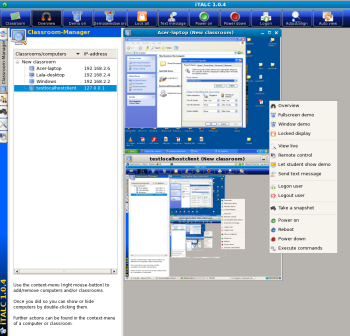Author: Mayank Sharma
iTALC, or Intelligent Teaching and Learning with Computers, is a didactical tool designed to assist teachers. Despite its name, the tool itself isn’t a learning environment. It’s meant to let teachers control their students’ computers in a computer-driven classroom setting. Thanks to its powerful remote desktop control features, simple setup, and lack of cost, it’s a potential remote assistance tool for any type of network.
iTALC is cross-platform and easy to install. There are binary packages and installation instructions available for several Linux distributions, including Debian, Ubuntu, SUSE, and Gentoo. You can also download the source package. I set up iTALC in Fedora from source without any issues and managed clients running other Linux distributions and Windows XP.
iTALC’s hardware requirements are modest. Its developer recommends 512MB RAM and 1GHz processor and a graphics card (the current breed of on-board graphics would do) on the master (teacher) computer. You’ll also have to install iTALC on all students computer as well. When installing iTALC on the student’s computer, select only the “iTALC Client Application (ICA)” option. To add a computer you’ll need to know its IP address and MAC address. The procedure is explained with screenshots on iTALC’s wiki.
The iTALC teacher interface is divided into tabs you use to add and manage students and classrooms and configure iTALC. There are also several buttons on the top on the screen to power on/off, view, and control individual students’ computers.
You can group student computers in virtual classrooms using the classroom manager under iTALC’s overview mode. The overview mode helps you keep track of all the connected students’ computers and monitor their activities by showing their desktops within individual windows.
When you want to demonstrate something to the students, you can jump to demo mode, under which the teacher’s screen is transferred to a pop-up window on all connected computers. This gives students the freedom to use their computers for other things if they don’t want to watch the demo. If you want their undivided attention, you can choose to lock their inputs by running the demo in full-screen mode.
On the other hand, if you want a student to show a demo, you can transfer his screen onto yours. Students can’t broadcast their screens to all other students in the class, however. If you want to work one-on-one with a particular student, you can do so using the remote control option by right-clicking on the student’s computer in the overview mode. This transfers control of the student’s desktop to you. If you want students to pay attention while you’re speaking, you can lock their desktops, thus blanking the screens and disabling all inputs.
Demo and monitoring activities are CPU-intensive tasks. As per the developers, overview mode with an update interval of 5 seconds takes approximately 20% of CPU power, and that percentage increases with shorter update intervals. Demo mode is also CPU-intensive, as screen data has to be managed and compressed for each client. However, network bandwidth utilization is low compared to other remote control applications (~1-2 Mbps total for 16 clients when doing standard desktop work).
If you have a big classroom or don’t want to shout an announcement, iTALC can send text messages to all connected students. If a student’s computer’s network card and BIOS supports Wake on LAN, you can also remotely power it on and off.
iTALC’s ability to control classroom computers goes beyond a local network. With a properly configured iTALC client, students can connect to a classroom from home via VPN. Teachers will see the students computer and be able to control it as if it were within the school network. iTALC would be a great distant learning tool if it could be enhanced to broadcast audio or webcam video from the classroom to remotely connected students.
iTALC can be used in any computer-driven lecture. I occasionally teach a hands-on Linux system administration course. By using iTALC, I can reach every student without a projector. Depending on the size of the class, iTALC can also save me from running around the lab.
The software can be useful outside of the classroom, too. Network admins might consider installing iTALC clients on all the computers in their network to help them administer the systems remotely. But since iTALC clients are all unprivileged users, any users who control the iTALC interface can snoop on everyone on the network without their knowledge. You can keep a client private by not starting ICA automatically when the computer boots up — check the iTALC manual for details.
iTALC has been designed to work in a standard workstation environment. However, the iTALC developer is working with the Edubuntu team to make it more suitable for thin-client LTSP environments.
iTALC is a nice little tool for classroom and presentation use and remote management. By taking lessons to students’ desktops, you not only save on the cost of a projector but get up close and personal with your students as well. If used with proper controls, iTALC can also save admins some troubleshooting time and effort when used in a traditional network.
Categories:
- Reviews
- Education & Training
- Desktop Software



